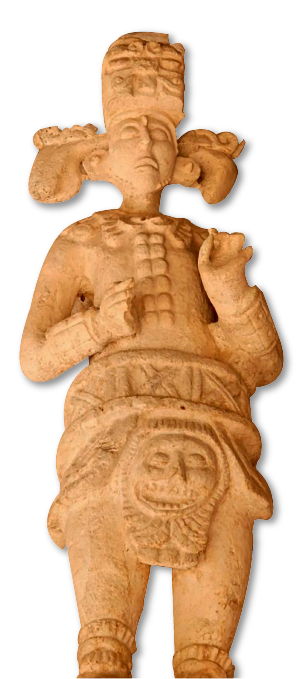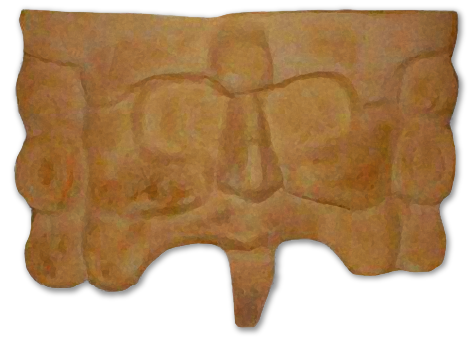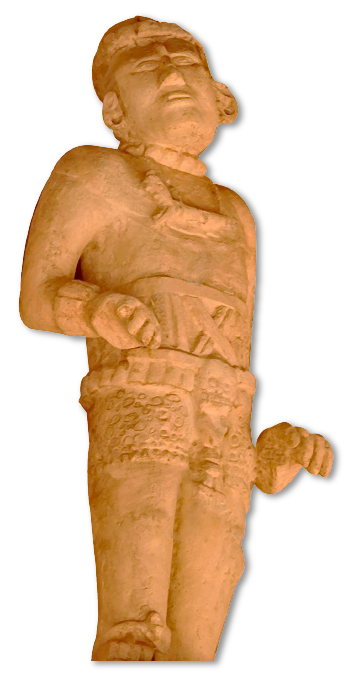Ek'Balam
El Palacio Real
¿Cómo se construyó la fachada y cómo elaboraron los antiguos mayas los relieves de estuco?
La edificación cuenta con muros de piedra caliza y mortero de cal y arena. Los muros fueron decorados con relieves de piedra, ensamblados unos con otros, y estos a su vez cubiertos por una capa gruesa de estuco, hecho de cal y arena media y gruesa. Estos materiales son muy abundantes en la región y se extrajeron de canteras y sascaberas cercanas.
El procesamiento de estos materiales consiste en la selección de las mejores piedras para producir cal a través del uso de la temperatura elevada en hornos especializados y el consecuente apagado de la cal viva en caleras hechas al aire libre. La selección de arenas en las sascaberas permitió diferenciar polvos de piedra que mezclados con la cal producen un concreto muy resistente y durable. En el caso de la fachada los estucos no fueron pintados como en otras partes de la Acrópolis, que lucían llamativos colores derivados del tratamiento de productos minerales y vegetales.
Los relieves de estuco se forman con una pasta de cal (hidróxido de calcio) proveniente de la calcinación de las piedras calizas a más de 900º C en horno. Una vez calcinadas se “apagaban” con agua y la pasta resultante se mezclaba con arenas finas, medias y gruesas para formar morteros. Estos morteros se modelaban con las manos y herramientas. Las pastas de mortero fresco solían tener soportes de piedra para sostenerse, adosadas a los elementos arquitectónicos (muros, frisos, cornisas), muchas veces las “almas de piedra” se tallaban en la misma forma, diseño y proporción que los relieves de estuco que les recubrían. Antes de secar y fraguar por completo se pintaban con pinturas minerales suspendidas en agua, o en algún otro aglutinante (gomas vegetales o proteínas animales). Una vez que fraguaba el estuco el color quedaba fijo sobre la superficie, aunque también se dejaban sin color, y se pulían en el proceso de secado para dejar la superficie impermeable.

How was the facade built? How did old mayas carry out the stucco reliefs?
The construction has limestone and lime and sand mortar walls, which were decorated with stone reliefs, assembled one with another, and coated by a large stucco layer, made of lime and mid-size and coarse sand. These materials are very abundant in the region and were extracted from nearby quarries and sascab quarries. The processing of these materials consists of the selection of the best stones for producing lime using high temperature in specialized kilns and the consequent slaking of quicklime in limekilns made in the open. The sands selection in the sascab quarries allowed the differentiation of stone dust that mixed with lime produce a very resistant and durable concrete. In the case of the façade the stuccos were not painted like in other parts of the Acropolis, that presented bright colors derived from the treatment of mineral and vegetable products.
The stucco reliefs are made with a lime paste (calcium hydroxide) coming from the calcination of limestone at more than 900° C in a kiln. Once calcinated they were “turned off” with water and the resulting paste was mixed with fine, mid-size and coarse sands for producing mortars. These mortars were modelled by hand and tools. The fresh mortar pastes used to have stone supports for holding up, attached to the architectonic elements (walls, frets, cornices), many times the “stone souls” were carved in the same form, design, and proportion that the stucco reliefs that coated them. Before drying and setting completely, they were painted with mineral paints suspended in water or in any other binder (vegetable gums or animal proteins). Once the stucco was set, the color remained fixed on the surface, even if they also left them without color and were polished in the process of drying so the surface would be impermeable.

¿Bix meetabil uchben pak'ilo'ob yéetel bix meeta'an tumen le mayaso'obo' le estukoso' obo'?
Le meeyajo’obo’ yan u pak’ilo’ob de tuunich laj po’olan yéetel ta’an yéetel u lu’umil ja’. Le pak’ilo’obo’ laj jatsutski’insa’an yéetel tuunich yéetel ts’a’an u jelo’ob tu yóok’ol, le’ lo’oba’ laj pixano’ob yéetel estukoo, meya’an yéetel ta’an yéetel u lu’umil ja’ ma’ jach pooloki’. Le ba’alo’oba jach yan te lu’umila’ tu’ux ch’abi tu’uxan pana’an lu’um. U tíial u meetal le balo’oba yan uu yeyaj u maasil jatsutsil tuunicho’ob u tíial u meetal ta’an ichil k’ako’ob yéetel u jejelas u t’aba’anil yéetel u jejelas tu’upul le ta’ano’ob ichil le t’aba’antak k’ako’obo’ meetan taankab. U tíial u yeya’ab le lu’umil ja’ te pana’an lu’umo’obo’ beychaj u k’ajolta’a jejelas lu’umulo’ob ku tal ti’ tunicho’ob ken xak’tak yéetel ta’an ku meetal ts’u’uy lu’um mun jan k’astaal. Te pak’o’obo’ le estukoso’obo’ ma’ bo’onobi’ je’ bix u jejelas Acropolis, laj leletskilo’ob yéetel jejelas bonilo’ob meetan yéetel jejelas balo’ob ku tal ti’ k’axo’ob yéetel balo’ob ich lu’um.
Le’ lu’umo’ob ti’ estukoo ku meetal yéetel u xa’ak’anil ta’an (idroxiido ti’ kalsyo) ku meetal ken laj yeelsa’ak tunich laj pola’an maas ti’ 900 C ti t’aba’antak k’ak’o’ob. Ken laj yeelsa’ak ku “tupa’al” yéetel ja’ le xa’ak’anilo’ ku ka’a xa’ak’taal yéetel u jatsutstakil lu’umil ja’, poloktak u tíial u meetal morteros. Le’ morteroso’obo’ ku meetral ka’achil yéetel k’ab yéetel u jejelas nu’ukulil meeyaj. Le xa’ak’anil ti le morteroso’obo’ ma’ jach xantako’ob meetano’ob ku meetal u yokmil yéetel tunich u tíial mun lu’ubil, je bix u meeyajil arkitektoniko’obo’ (pak’ilo’ob, frisoos yéetel kornisaas) ya’ab u teenakile’ u “u pixanilo’ob le’ tunicho’obo’ ” ku pola’ab je bix u yochile’, u meeyajile yéetel u poolokile’ je bix le estukoso’obo ku laj bak’a’al. Bex ma’ tiijik tu lakalo’ob ku laj bo’onol yéetel bonilo’ob ku meetal yéetel balo’ob ich lu’um meetan yéetel ja’, wa ti’ u jejelas ba’al (balo’ob ku tal ich k’ax wa balo’ob ti’ balcheo’ob). Ken tsoko’ob u ts’ama’ab le estukoo le bonilo’ob ku p’atal u yok’oliil, kex beyxan ku p’atal bex mina’an u boonile’, yéetel ku poolal ken tijiik u tíial u p’atal leletski.

